Dealing with bed bugs is something that we all eventually have to do if we enjoy traveling. But when bed bugs hit, they hit hard, and if you aren’t cautious, you can bring them back home. If they spread throughout your household, the only way of truly getting rid of them is by paying ridiculous sums to insect treatment crews.
Don’t worry though, because if you know how, you can deal with bed bugs quite easily. In this article, we’ll teach you how to get rid of bed bugs from your luggage, your clothing, and anywhere else, so they don’t spread to your household.
How to Get Rid of Bed Bugs in Luggage (Quick Guide)
- Isolate them from spreading. Put all of your clothing in sealed plastic wraps.
- When home, leave your clothes and suitcase outside. Don’t bring your current clothing, the suitcase, or the contents of it inside, as this could spread bed bugs throughout your whole house.
- First, treat your clothes. Put the contents of your luggage and your clothing in a dryer on the hottest cycle for 20-30 minutes, which is enough to kill bed bugs.
- Vacuum your suitcase. This will get rid of most bed bugs. Make sure to dispose of the vacuum bag as well.
- Kill the remaining bed bugs. Use insect pesticides or a professional steam cleaner (above 160F degrees) to kill all remaining bed bugs.
- Vacuum again and do a final inspection. First vacuum everything to get rid of all the dead bed bugs, leave your suitcase outside for a week, and come back to do a final inspection. Your suitcase should now be bed-bug-free.
How to Get Rid of Bed Bugs in Luggage (Long Guide)
Step 1: Put Your Clothes in Sealed Plastic Bags
If you’re on vacation and you just noticed bed bugs, the first thing you should do is isolate the problem to stop them from spreading. First of all, go to hotel management, let them know about the problem, and ask for a different room. Before switching rooms, try to shake off and remove as many bed bugs from your luggage, clothes, and other items as you can.
Next, you should go to a local convenience store and get a few plastic bags and tape. Garbage bags will do just fine. Put all of your clothes inside the plastic bags, seal off the ends with tape and place everything back in your suitcase. If you still have a few days of vacation left, separate your clean clothes from used ones, and try to keep your luggage on a shelf or inside a closet for the rest of your trip. The best option would be to put all of your items inside the plastic bags and buy new clothes to last you for the rest of the trip.
Step 2: When You Come Home, Keep Your Suitcase in a Safe Place
When you finally arrive home, keep your suitcase in an isolated place outside of your home, like on the porch or in a shed. It’s also a good idea to take off all of your current clothes, put them straight inside the washing machine, and take a shower to avoid getting any bed bugs inside your home.
Step 3: Start by Treating Your Clothes
First, you should get rid of all the bed bugs from your clothes which is easy to do if you have a washing machine and a dryer. Open your plastic bags, place clothes inside the washer, and get rid of the plastic bags by taking them to a dumpster. Don’t put the empty bags in your personal garbage can! Wash in the hottest possible temperature. This process will kill most bed bugs, but not all of them. Next, dry your clothes in a medium or hot cycle for 20-30 minutes. This will be enough to kill off all the remaining bed bugs as well as all the eggs.
Step 4: Vacuum Your Suitcase Throughout
Once you’ve cleaned all of your clothes, some bed bugs and eggs will remain in your luggage. To get rid of them, vacuum your suitcase throughout. Use the tiny adapter to get to all of the pockets and crevices, especially around the zippers.
Step 5: Get Rid of All the Remaining Bed Bugs
Vacuuming isn’t enough because there are still some bed bugs and their eggs left inside all the crevices that are hard to reach. You can kill bed bugs with an insect pesticide or hot/cold treatments. If you’re okay with using pesticides, spray the whole suitcase with an aerosol spray meant for killing bed bugs and wait a few minutes for it to work. You can find these in most convenience stores.
If, however, you’d like to use something more natural, you could kill them off with hot/cold treatments. If it’s summer, and you have a greenhouse or a car that gets above 120 degrees Fahrenheit during the day, you could wrap your suitcase in a large plastic bag, seal it off with tape, and let it sit for a few hours in hot temperatures, which would kill them off. And if you have a large enough freezer, you could place your infested suitcase inside. That said, it takes a while to kill them off with cold treatments. They start to die at 32 degrees Fahrenheit but take weeks to do so. At 0 degrees Fahrenheit, they’ll take four days to freeze to death.
Another popular treatment is killing bed bugs with steam cleaners. At around 160 degrees Fahrenheit hot steam, bed bugs die off instantly. Not all steamers heat this high, so you may need to rent a professional steamer to do the trick. Steaming your whole suitcase slowly and carefully until the surface gets damp but not completely wet will kill off all the hidden bed bugs and their eggs.
Step 6: Vacuum All the Dead Bed Bugs, and Do a Final Inspection
Finally, when you’ve killed all the remaining bed bugs, vacuum your suitcase one last time to clean off all the killed bed bugs and their eggs. Inspect the suitcase thoroughly to check if you’ve removed everything. Once you’ve finished, make sure to get rid of the vacuum bag by throwing it in the dumpster outside your house.
Read Next: How to Clean Your Suitcase in 20 Minutes or Less
How to Prevent Bed Bugs From Getting Into Luggage While Traveling
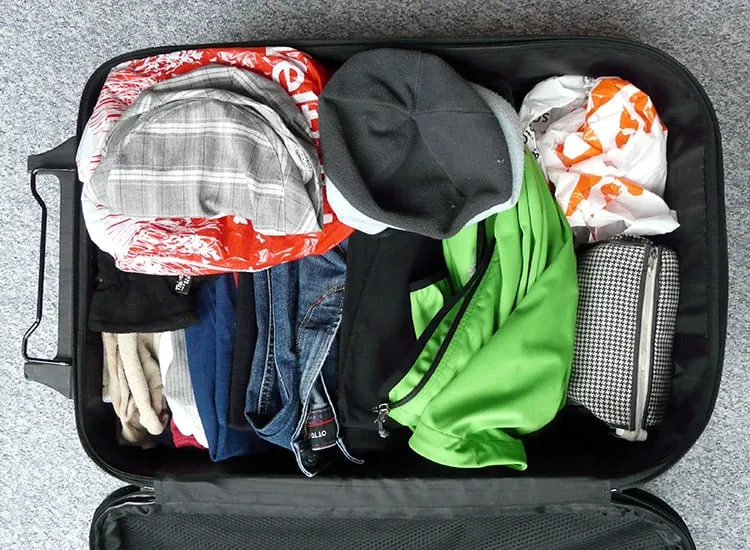
If you’re staying in budget accommodations, it may be a good idea to protect yourself from a potential bed bug infestation. You can do that by following a few guidelines.
Use Plastic Covers for Luggage
Usually, we keep spare garbage bags inside our suitcases if we know we’ll be in budget accommodations. When we arrive, we take everything we need out of the suitcase and place it inside the large garbage bag. This ensures that no bed bugs will get inside. You can also find dedicated luggage covers that claim to aid in avoiding bedbugs. Unfortunately, we haven’t had any luck in finding a good one so far.
Keep Your Suitcase off the Ground
Bed bugs are most commonly found on the flood and in beds (hence the name bed bugs.) So it’s a good idea to keep your suitcase off the bed and ground at all times. Instead, try keeping your luggage on a shelf or in a closet so bed bugs can’t get inside. Also, try to keep all of your clothes inside your suitcase instead of unpacking everything.
Store Your Dirty Clothes Inside a Sealed Plastic Bag
Bed bugs are drawn to body heat, sweat, and the carbon dioxide that you breathe out. Your dirty clothes produce scents that are very attractive for bed bugs, so it’s a good idea to keep your dirty clothes inside a sealed plastic bag. This way, they won’t be drawn to the smells inside your suitcase.
Other Commonly Asked Questions About Bed Bugs
How to Get Bed Bugs Out of Purses, Totes, Duffels, and Backpacks?
Getting bed bugs out of smaller, flexible bags is much easier compared to large, bulky suitcases. First, you need to wash your purse, tote, duffel, or backpack in a washing machine on a hot cycle. This will kill off most of the bed bugs, but not all. Next, you need to put your bag in a dryer on the hottest setting for about 20-30 minutes, which is enough to kill all the remaining bed bugs.
How Do Bed Bugs Look Like?
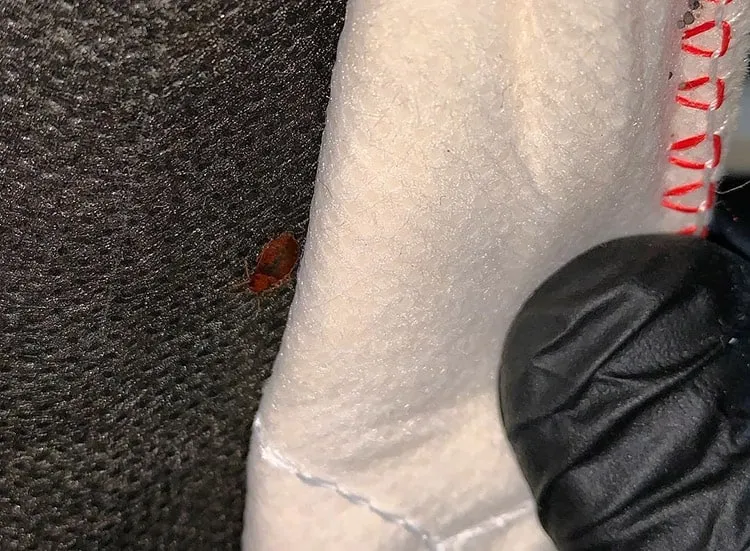
In the picture above, you can see quite a large bed bug. Grown adults will look similar to the picture above, but their younger peers are much smaller. Still, they’re larger than ticks and fleas. Bed bugs have large bellies, six legs, and two front antennas. Male and female bedbugs are different in appearance, with the female appearing to be smaller and rounder while the male is longer and slimmer. They usually are in brown/yellowish color and, besides the black droppings you will find everywhere, you’ll also see white/transparent eggs that look similar to tiny rice grains.
Can Bed Bugs Get Inside Closed, Zippered Luggage?
Unfortunately, bed bugs can get through most zippers, even if they’re closed. Of course, having a closed suitcase will significantly lower the chances of bed bugs getting inside, but they still will be able to get through the small gaps between the zipper teeth.
P.S. Most zipperless hard-shell suitcases, with tight aluminum zipperless sections, are bed-bug-proof. You can check out our comparison of the best zipperless suitcases over here.
How to Know If You’ve Bought Bed Bugs Home?
If you’ve had any bites during your vacation that resemble bed bugs or flea bites, it’s best to do a throughout inspection of your luggage before you go home. Look at all the tiny crevices of your suitcase (especially around the zippers) and your clothes, especially the dirty clothes because bed bugs are attracted to dirty laundry. If you find their droppings, eggs, or bed bugs themselves, you should do a full bed bug removal treatment on all of your clothes and luggage. If you can’t find any, that still doesn’t mean that you’re bed-bug-free. It’s best to do a full treatment anyway if you have any bites that resemble bed bug bites because dealing with a bed bug house infestation is a hundred times worse than doing a full treatment on your clothes and luggage.
Which Bed Bug Sprays Work on Luggage?
You must select a bed bug spray carefully because not all sprays will be as effective. Also, you should apply them carefully and try to spray all the crevices of your suitcase. Low toxicity sprays like SteriFab™ or Bedlam® are only effective when applied directly to and throughout the infected area. Alcohol and soap-based sprays are only partially effective because they don’t kill the eggs. Most bed bugs are somewhat resilient to Pyrethroid sprays. EcoRaider™ and Bed Bug Patrol™ are two plant oil-based pesticides that have recently proven to be extremely effective against killing bed bugs. You can find more info about pesticides for bed bugs over here.
Do Handheld Steamers Kill Bed Bugs?
Bedbugs are killed instantly by steam in 160 degrees Fahrenheit or more. Most handheld steamers will reach these temperatures, but professional ones will get even better results. If you’re using a cheaper handheld steamer, make sure that it has a constant steam flow. If the steam flow is consistent and thick, you should be able to kill all the bed bugs from your luggage. But to be sure, you’ll have to use a handheld thermometer to see if the steam reached 160 degrees Fahrenheit.
When it comes to removing bed bugs from your suitcase, you will want to remove any brush attachments from the steamer before you start steaming. Use the steamer in slow movements and make sure to cover each spot for at least 30-60 seconds. You want the fabric to become hot and damp but not completely wet. Once you’ve finished the whole suitcase, let it dry. To make sure that the treatment is effective, repeat the process one more time.
What Temperature Kills Bed Bugs?
Bed bugs can’t survive in extreme temperatures. Heat treatments are usually more effective in treating bed bugs. Bed bugs start to die at 117-123 degrees Fahrenheit. A hot washer cycle is enough to kill off most bed bugs. For a more thorough treatment, use your dryer in the hottest setting for at least 20 minutes. Heat boxes and saunas above 120 degrees are also effective methods.
Freezers with temperatures below 0 degrees Fahrenheit are also effective but require around four days for all the bed bugs and their eggs to die. Although bed bugs start to die below 32 degrees Fahrenheit, it may take weeks for them to die, and eggs won’t die off until you reach lower temperatures. You should use cold treatments only below 0 degrees Fahrenheit.
How Long Can Bed Bugs Survive Inside Luggage?
Nymphs (a newly hatched bed bug) can survive a few weeks without eating anything. Full-grown bed bugs can survive for up to five months without feeding. So you could potentially wrap up your suitcase in a plastic bag, seal it off completely, and let it sit for about six months until all the bed bugs die off hunger.
Do Bed Bugs Survive in a Washing Machine?
Hot settings of washing machines are usually at 130 degrees Fahrenheit. Because bed bugs die off at around 120 degrees Fahrenheit, washing them in 130 degrees is enough to kill off most of them. That said, it won’t kill all of the bed bugs because water cools off quickly, and the eggs are harder to kill. So using just a washing machine on a hot setting isn’t enough to kill bed bugs. After washing, you should continue by placing your clothes in a dryer on a hot setting for at least 20 minutes, which will be enough to kill all the remaining bed bugs.
Do Bed Bugs Suffocate Inside a Sealed Plastic Bag?
It’s impossible to kill bed bugs inside sealed bags, even inside vacuum-sealed ones. Although bed bugs die off without oxygen, even vacuum-sealed bags have some air left in them, and bed bugs don’t need much, so they’ll survive. The only way they’ll die is if you keep the bag completely sealed for at least six months because they will die from starvation.
Can Bed Bugs Eat Through Plastic?
Using plastic is the only effective way that we’ve found to securely transport bed bug-infested suitcases. But can they eat through that plastic? Luckily, bed bugs can’t chew through plastic because they don’t have teeth! Bed bugs use a proboscis, a needle-like, beak to pierce your skin. That doesn’t mean you’re completely safe, though, as they can fit through very small holes in the plastic. We recommend using layers of garbage bags!
Can You Shake Bed Bugs off Your Clothes?
By shaking your contaminated clothes, you can get a few larger bed bugs off, but it isn’t enough to get all of them off. Smaller, younger bed bugs and their eggs will most likely still hide near all the seams, so shaking off bed bugs isn’t really that effective.
Can Bed Bugs Travel With You on Your Clothing?
Bed bugs like to live in a calm, stable environment, like your bed or your luggage. Transporting them through your clothing is possible, but it’s unlikely. That said, if you think that you’ve been infested with bed bugs while traveling, we would definitely recommend you to take off your clothing before coming back home, as there’s still a small chance that they’re hidden in your clothing.

 (5 votes, average: 4.40 out of 5)
(5 votes, average: 4.40 out of 5)
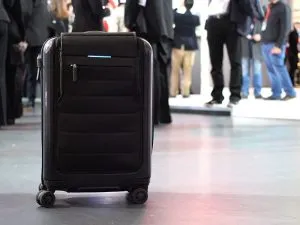
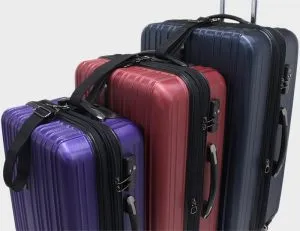
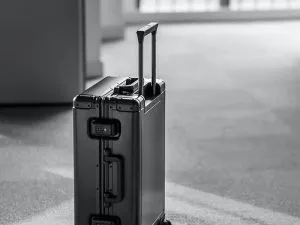
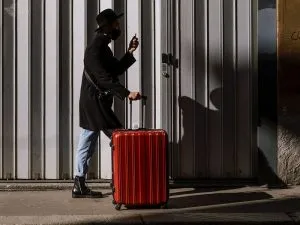
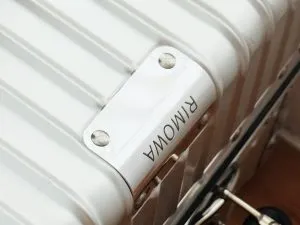








Oscar, your words resonated with me on a deep level! As a fellow outdoor enthusiast, I too have felt the serenity of a sunrise hike in the Rockies. Could the tranquility be attributed to the absence of modern distractions? Also, have you ever experienced the same calmness in an urban setting? I believe cities, with their own unique rhythms, can offer a different, yet equally rewarding form of serenity. As for encouraging others to connect with nature – what if we introduce more urban gardens? This could be a stepping stone to larger adventures. Just some food for thought! Keep up the amazing work, Oscar! 🙌🌳